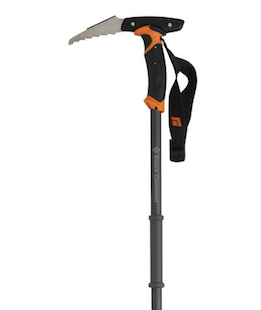Ski Mountaineering: Whippet or Ice Axe?
by Michael Powers, IFMGA
AAI Senior Guide & Director for Staff Development
 Question:
Question:
From the January 2007 edition of AAI's E-newsletter
I am looking to get out in backcountry skiing more, and have noticed there is an option for a ski pole with an ice axe pick on the top, specifically, the Black Diamond Whippet. Is this a good item to have, or should I just carry an ice axe on my back and use it when necessary? What do you use? Thanks!
- Sarah Jorgenson (Bend, Oregon)
Answer:

A Black Diamond Whippet self-arrest ski pole.
Dear Sarah,
Great question. As you might imagine, a Whippet can come in handy on certain slopes. As you might also imagine, a Whippet is no substitute for a proper ice axe when the terrain necessitates a more serious tool.
A Whippet is a ski pole with an ice pick-like attachment that can be used to self-arrest on steep snow slopes. It does not offer the holding power (nor the strength or multi-function) of a designated ice axe, but it can be sufficient to hold a small slide and thus prevent a larger fall. A conventional ice axe, on the contrary, offers a larger pick and a stronger shaft, which increases the chance of self-arresting.
Let's talk about actual use of a Whippet and what situations you are likely to be in. Neither an ice axe nor a Whippet will help when falling on very steep hard slopes. Your best hope is to stop the slip before gaining momentum - that is, before it turns into an actual fall. In such a case, a Whippet is helpful because it's already in your hand and can be applied to the slopes quickly. An ice axe, on the other hand, is much more difficult to ski with and prevents you from using a pole in your hand, thereby putting you in a defensive ski position that in turn may make you more likely to fall.
I'll describe how I decide what piece of gear to use:
- If I'm climbing a big mountain – ski mountaineering for a ski descent – I'll usually have an ice axe with me - especially on a glaciated peak, but also on non-glaciated peaks that are likely to have some ice. Since I am already taking the ice axe with me in this scenario, I'll leave the Whippet behind (to save weight) and use regular ski poles. If the terrain gets very exposed and it seems likely I wouldn't be able to stop myself if I fell, I may pull out my axe (a rare occurrence, by the way). At this point, I wouldn't really be linking my turns, but instead just side-slipping down or traversing.
- If I'm going out on a moderate backcountry ski tour, or if it's winter and I know the snow will be deep, I won't bring an ice axe or a Whippet, just regular ski poles.
So, you may wonder, when would I take a Whippet? The answer is: only if I know what conditions to expect. If I've skied the mountain before, and there is a high likelihood of steep, hard snow that will get softer during the day (corn snow, for example), then I leave the ice axe behind and consider taking the Whippet. That way, in case the slopes are a little harder than I expected on the descent, I have a method for protecting myself from a major slip. I still may leave the Whippet, however, if I'm at the trailhead, can somehow get a sense of what the conditions are, and conclude that the snowpack will be softened up. If I do leave the Whippet behind, I'll plan on managing the risk of falling down steep snow slopes in other ways - by picking a different line or skiing the line more conservatively.
You should understand that the Whippet is of limited use and is a compromise. I think it's most useful for skiing steep, spring slopes on terrain where I know what to expect. And as much as I like having one when I pack my ski gear in the morning, I find that more often than not, it stays behind in the car. But on those days when weight isn't an issue, a Whippet (even in the bottom of my pack) can keep more of my options open.
- Mike Powers
Click the link to return to "Ask A Guide" Letters.
Program Finder